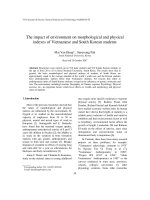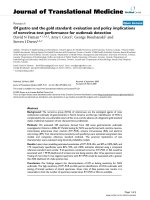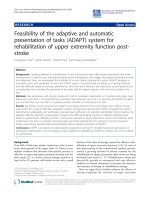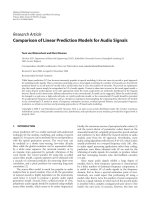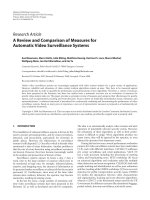STABLE AND PHYSICAL RESPONSE OF CONVEX HYPERELASTIC MODELS FOR FIBRE REINFORCED MATERIALS ỨNG xử tự NHIÊN và ổn ĐỊNH của các mô HÌNH SIÊU đàn hồi lồi mô tả các vật LIỆU COMPOSIT cốt sợi
Bạn đang xem bản rút gọn của tài liệu. Xem và tải ngay bản đầy đủ của tài liệu tại đây (710.15 KB, 8 trang )
Kỷ yếu hội nghị khoa học và công nghệ toàn quốc về cơ khí - Lần thứ IV
STABLE AND PHYSICAL RESPONSE OF CONVEX HYPERELASTIC
MODELS FOR FIBRE-REINFORCED MATERIALS
ỨNG XỬ TỰ NHIÊN VÀ ỔN ĐỊNH CỦA CÁC MÔ HÌNH SIÊU ĐÀN HỒI LỒI
MÔ TẢ CÁC VẬT LIỆU COMPOSIT CỐT SỢI
Minh Tuan Duong1a, Thi Thanh Hai Tran1b
Hanoi University of Science and Technology, Hanoi, Vietnam
a
;
1
ABSTRACT
Fibre-reinforced hyperelastic models characterising rubbers, fibre-reinforced
elastomers, and biological soft tissues (e.g. arteries), can be unstable and lead to unphysical
behaviour. This problem is due to the ill-conditioned constitutive matrix of the model. Thus,
the paper analyzes this numerical instability by investigating a hyperelastic model in which
the fibres characterised by a 2D Fung-type potential and an isotropic term representing the
matrix, namely the modified Fung-type one (MFH). The unrealistic response of the convex
MFH might take place in physiological range of soft tissues or in interested range of
hyperelastic materials. Several tension tests are conducted with the material constants of the
MFH obtained from curve fitting to experimental data of porcine arterial samples by G. A.
Holzapfel, which show poor stress solutions associated with unrealistic thickness thickening
of the tested specimens. Consequently, the paper proposes a novel Fung-type potential which
solves this numerical instability and can ensure physical response in the physiological
deformation range of the artery.
Keywords: Unphysical response, Ill-conditioning, FEM, Hyperelastic models, Fibrereinforced materials.
TÓM TẮT
Ứng xử phi tự nhiên có thể xảy ra đối với các mô hình siêu đàn hồi dùng cho mô tả cao
su, vật liệu dẻo cốt sợi hay mô sinh học. Vấn đề này xảy ra là do ma trận cấu thành của mô
hình vật liệu ở dạng điều kiện yếu. Vì vậy bài báo phân tích sự mất ổn định số này bằng việc
khảo sát một mô hình siêu đàn hồi trong đó các sợi được mô tả bằng hàm năng lượng biến
dạng Fung 2D và chất nền được mô hình hóa bằng hàm biến dạng đẳng hướng, gọi là mô hình
sửa đổi dạng Fung (MFH). Ứng xử phi tự nhiên của mô hình lồi MFH này có thể xảy ra trong
vùng biến dạng sinh học của mô hay vùng biến dạng được quan tâm. Kết quả mô phỏng của
một số thí nghiệm kéo đơn dùng mô hình này với các hệ số vật liệu được xác định từ các mẫu
lấy từ động mạch của lợn được thí nghiệm bởi G. A. Holzapfel đều thiếu chính xác và không
phù hợp với kết quả lý thuyết đồng thời kèm theo độ dầy của các mẫu trong các thí nghiệm
tăng lên một cách phi vật lý. Do đó, bài báo đề xuất một mô hình mới dạng Fung giải quyết
được vấn đề mất ổn định số trên và đảm bảo ứng xử tự nhiên của mô hình mới này trong vùng
biến dạng sinh học của động mạch.
Từ khóa: ứng xử phi tự nhiên, điều kiện yếu, FEM, mô hình siêu đàn hồi, vật liệu dẻo
cốt sợi.
1. INTRODUCTION
Fibre-reinforced materials play an important role in a wide range from biomechanics [1]
(e.g. biological soft tissue: arteries) to aircraft industry (fibre-reinforced elastomers for
flexible aircraft structures) [2]. Constitutive equations are not only capable of capturing the
890
Kỷ yếu hội nghị khoa học và công nghệ toàn quốc về cơ khí - Lần thứ IV
material behavior of composite materials accurately, but must ensure numerical stability.
Herein, hyperelastic materials are mainly considered in biomechanics such as soft tissues,
however this instability problem can occur in any fibre-reinforced composite models used in
flexible aircraft structures or engineering. Obviously, the modified Fung-type model (MFH)
[3] and the Holzapfel model [1] are convex [4] and are typical examples subjected to
unphysical response in numerical simulation with thickness thickening of specimen strips in
uniaxial tension tests. Gasser et al. [5] claimed that the problem was caused by fibre rotation
in which the fibres needed to rotate into the loading direction in a soft ground matrix, and
hence, this process resulted in thickness thickening in the middle of the simulated specimen.
Indeed, this statement is wrong because the problem is a numerical instability. For example,
this unrealistic phenomenon also takes place in an equi-biaxial test using the MFH model and
the Holzapfel model in which the fibre directions are unchanged under deformation, see [6].
Therefore, it is needed to analyze this numerical problem to ensure the correct simulations.
This paper presents further solutions to this problem, especially for the MFH model. To this
end, we propose a novel model comprising a new strain energy component which is capable
of solving the unphysical response of the MFH model in the interested deformation range.
2. HYPERELASTIC MATERIAL MODEL
The stress tensors of homogeneous hyperelastic materials are directly derived (by means
of the Clausius-Planck form of the second law of thermodynamics) from a given scalar-valued
strain-energy function
S=2
∂W (C) ∂W (E)
=
,
∂C
∂E
(1)
where E is the Cauchy-Green tensor, S is the second Piola-Kirchhoff stress tensor and
the left Cauchy tensor C = FT F with the deformation gradient tensor F . The Cauchy stress
tensor σ = J −1FSFT , in which J is the determinant of the deformation gradient (volume
ratio). These types of equations are known as constitutive equations. The constitutive
equations for composite materials are expressed in a finite element model as in the following.
2.1. Finite element formulation
The total Lagrangian formulation is used since considered tensors in the previous
section are described in the reference configuration. A variational theorem for finite elasticity
may be written using hyperelastic materials as
=
Π
dV − Π
∫ W (C)=
∫ W (C)dV − ∫ b
ext
Ω0
0
Ω0
Ω0
⋅ udV − ∫ u ⋅ T dS ,
(2)
Γ0
in which W (C) is the strain-energy function in the reference configuration Ω0 , Γ 0 is the
traction boundary surface, u is the nodal displacement vector; b0 and T are the body force and
the specified traction in the reference configuration Ω0 , respectively. The variational equation
[7] for the weak form of the problem might be rewritten for the finite deformation as
δΠ (u, δ u) =
δ uT ⋅ ∫ BT SdV −
Ω
0
T
T
−
N
b
dV
N
T
dS
0,
=
0
∫
∫
Ω0
Γ0
(3)
where B and N are the displacement deformation matrix and the shape function
matrix, respectively. In general, solving nonlinear problems needs to adopt load increments
through a load factor λ. The principle of virtual work with the external load factor λ reads as
δΠ (u, δ u) =
δ uT ⋅ R(u, λ ) =
δ uT ⋅ [ Fint (u) − λ Fext (u) ]
891
,
(4)
Kỷ yếu hội nghị khoa học và công nghệ toàn quốc về cơ khí - Lần thứ IV
where R(u, λ ) denotes the out-of-balance force or residual force which must be equal to
zero to ensure equilibrium. Thus, R(u, λ ) can be evaluated as
R(u, λ ) =Fint (u) − λ Fext (u) =0,
(5)
where the internal force Fint and the external force Fext of an element, which can be
introduced from the first integral of the principle of virtual work (3) reads as
Fint =
∫B
T
SdV ;
=
Fext
Ω0
∫N
Ω0
T
b0 dV − ∫ N T T dS
(6)
Γ0
The system in (5) is nonlinear discrete governing equation because of both
geometrically and physically nonlinearity from large deformation and the constitutive relation
of the material, respectively.
As a result, the total classical tangent stiffness matrix K t must be defined as
K t ∆u = R ,
Kt =
∂Fint (u)
∂F (u)
− λ ext
.
∂u
∂u
(7)
Taking the derivative of the internal force vector with respect to the displacements
yields
∂Fint (u)
=
∂u
∂BT
T ∂S ∂E
dV
∫Ω ∂u S + B ∂=
∂
E
u
0
∂BT
T
∫Ω ∂u SdV +Ω∫ B DBdV
0
0
(8)
where D is the constitutive matrix derived from the hyperelastic model.
2.2. Stability of the MFH model
Gasser et al. [5] have been discussed the unrealistic behaviour of the Holzapfel model,
however they could not show the real reason. In this section, we point out the unphysical
response of the MFH model as a typical example when the model is used to describe
reinforcing fibres embedded in a soft material. Numerically, this problem is due to the illconditioned constitutive matrix of the model [6].
Figure 1: Fibre families of an artery (without intima) and a strip for tension test
When a 2D Fung potential models fibres in a plane Oθ z then the model with the fibre
orientation vectors a 0 , g 0 in Figure 1, the MFH model [3] is written as
) µ ( I1 − 3) + C exp {Q fibre (E)} − 1 ;
WMFH ( E=
2
892
Q fibre (E=
) c1 Eθθ2 + c2 Ezz2 + c3 Eθθ Ezz (9)
Kỷ yếu hội nghị khoa học và công nghệ toàn quốc về cơ khí - Lần thứ IV
where Err , Eθθ , and Ezz are principal components of the Green deformation strain E
with respect to reference configuration in Figure 1; the invariant I1 of the right Cauchy-Green
tensor C : I1 = tr C ; µ equivalent to the small strain shear modulus; c1 , c2 , and c3 are
dimensionless parameters so that the angle between two fibre families along the hoop
2c3
direction is defined by tan(2α ) =
, tan(2α l )(c1 − c2 ) ≤ 2c3 ≤ tan(2α u )(c1 − c2 )
c1 − c2
where α l and α u are the lower and upper limits for the fibre angle, respectively. The
component Waniso contributes mechanical properties only in the fibre plane Oθ z as an
exponential function, whereas the polynomial function W=
0.5µ ( I1 − 3) characterizes
iso ( I1 )
the material response in all directions. This can result in the same ill-conditioning problem as
described above even the model is convex. The constraints for the convexity of the model are
derived as c1 , c2 , c3 > 0; c1c2 − c32 > 0.
Figure 2: Curve fitting and stress resutls of uniaxial tension tests for the MFH model
Figure 3: Unphysical response (left), different stretch solutions (right) of the MFH
To obtain the material constants for the MFH model, a curve fitting phase was
performed on the adventitial data [8], see Figure 2. All coefficients are not only fitted but
checked for the convexity conditions.
Model
MFH
Table 1: Fitted parameters for the MFH
C [kPa]
c2
c1
µ = µ kPa]
*
22.722
0.16
180.08
893
373.14
c3
α [°]
245.05
55.75
Kỷ yếu hội nghị khoa học và công nghệ toàn quốc về cơ khí - Lần thứ IV
Simulation results of the uniaxial tension test using the material constants in Table 1 with
the shear modulus µ * = 22.72 [kPa] are shown in Figure 3, the unphysical behavior occurs at
very low stretch, leading to an inaccurate Cauchy stress σ z curve of the MFH in Figure 2.
Three values of the shear modulus (remaining constants were unchanged) were
employed in the simulation, illustrated in Figure 3; the red one is for µ = 0.1µ * , the blue one
is simulated with the shear modulus µ = µ * and the last one (violet) uses µ = 10 µ * . It is
obvious that the largest shear modulus accounts for the best radial stretch which gradually
decreases due to the incompressibility constraint=
J det
=
F 1 . Subsequently, this value
makes the model more stable and the result is, of course, closer to the analytical. The
numerical stability of the model strongly depends on the isotropic strain-energy function (neoHookean one). The unphysical behavior (the radial stretch increasing) is clearly exhibited as
the shear modulus decreases.
This problem is observed as the constitutive matrix is ill-conditioned and is caused by
the large difference between the isotropic energy and the anisotropic energy [6]. Thus, we can
control properly the balance between the isotropic and the anisotropic strain energy functions.
Practically, tissues generally have fibre dispersion, in which the fibres are placed not only in
the fibre plane but in any direction out-of the fibre plane. Therefore, the overall model needs
to be modified in a way such that the isotropic component must be characterized by
exponential functions. Different from the MFH model, the novel model based on the Fungtype potential was proposed to characterize the fibres in all directions by adopting the
principal Green-Lagrange strain component E1 (out-of the fibre plane) in the exponential
term. Thereby, it is capable of describing the fibre dispersion in order to remove/mitigate the
numerical instability known as the non-physical response.
3. NOVEL FUNG-TYPE MODEL
By incorporating the capability of being immune from material instability of a isotropic
Fung-type model [6], a novel Fung-type model (MF2) is proposed for treating the illconditioning problem of the MFH. This model is formulated by taking the fibre dispersion
into consideration. The isotropic Fung-type model in [6] can be used to model the fibre
dispersion when combined with the MFH model. On the other hand, the mechanical
properties contributed by the fibres are modeled by a 2D Fung-type model [3]. To this end,
the proposed strain-energy function with the fibre plane in O 23 or Oθ z is postulated as
µ
(I1 − 3) + Wcoup ( E ), Wcoup ( E )= C[exp{Qcoup ( E )} − 1],
2
(10)
coup
2
2
2
2
2
Q =(1 −ν 1 ){c1 ( E11 + E11 + E11 ) + 2c2 ( E11 E22 + E22 E33 + E11 E33 )} +ν 1{c3 E22 + c4 E33 + c5 E22 E33}
W=
3.1. Stability of the model
If the exponent Qcoup is convex then the proposed model is logarithmically convex [9].
The exponent Qcoup is a quadratic function of E therefore Acoup is the Hessian matrix of
Qcoup . Thus, if Acoup is positive definite then the exponent Qcoup is convex. Specifically,
Acoup is positive definite when constraints on 8 material constants are expressed as
0 ≤ ν 1 ≤ 1, ( µ , C , c1 , c2 , c3 , c4 , c5 ) > 0 , (1 −ν 1 ){(c12 − c22 )(1 −ν 1 ) + c1c3ν 1} > 0 and
c1 (1 −ν 1 )
c2 (1 −ν 1 )
c2 (1 −ν 1 )
c2 (1 −ν 1 ) c1 (1 −ν 1 ) + c3ν 1 c2 (1 −ν 1 ) + c5ν 1 > 0.
c2 (1 −ν 1 ) c2 (1 −ν 1 ) + c5ν 1 c1 (1 −ν 1 ) + c4ν 1
894
(11)
Kỷ yếu hội nghị khoa học và công nghệ toàn quốc về cơ khí - Lần thứ IV
The constraints in (11) were checked after the material constants of the model were
obtained from the curve fitting process. Only the satisfying parameters were utilized in the
numerical example section. The material coefficients of the model become more meaningful
compared to those of the general Fung-type strain-energy function [10]. Moreover, the
weighting coefficient ν 1 , which might be considered as a fibre dispersion factor, plays an
important role to balance the difference between the isotropic strain energy and the
anisotropic one. If ν 1 = 0 then the whole model becomes fully isotropic. In contrast, ν 1 = 1 ,
the term Wcoup totally turns into an anisotropic one, and the overall model becomes the MFH.
This material law can be comparable to others taking the fibre dispersion into account [5].
3.2
Implementation into open source code-FEAP
To implement a material model into a finite element package such as FEAP [11] or any
numerical schemes, the expressions for the hyperelastic stress and the constitutive matrix are
required. Soft tissues are, in general, considered to be incompressible or nearly
incompressible. For the case of nearly incompressibility, the elastic energy can be written as a
function of the following modified deformation tensor which are defined in [10] as
−1/3
=
F J=
F ; C J −2/3C.
(12)
The Green-Lagrange strain tensors are subsequently defined as
E=
1
2
(FT F - I) =
1
2
(C - I)
E=
1
2
(FT F - I) =
1
2
(C - I) .
(13)
Employing the Voigt’s notation, the modified Green-Lagrange strain is expressed in the
matrix form as E = [ E11 , E 22 , E 33 , 2 E12 , 2 E 23 , 2 E 31 ]T . The novel Fung-type strain-energy
function in a form of nearly incompressibility is
=
Wcoup C[exp( E T ⋅ A ⋅ E ) − 1].
(14)
The second Piola-Kirchhoff stress vector, which is calculated from Wcoup is
=
Scoup
∂Wcoup ∂E ∂Wcoup
∂E
( AE ),
=
= 2CeQ
∂E
∂E ∂E
∂E
(15)
where
∂E ∂C ∂ ( J −2 / 3C )
∂C
∂J −2 / 3
1
=
=
= J −2 / 3
+C ⊗
= J −2 / 3 ( I 6×6 − C ⊗ C −1 )
3
∂E ∂C
∂C
∂C
∂C
(16)
with I 6×6 is identity matrix of dimension 6×6; C −1 is a vector that contains components
of tensor C−1 in order of the Voigt’s notation. We only calculate the constitutive matrix,
which is derived from Wcoup as
=
Dcoup
∂ 2Wcoup ∂E
∂Q ∂E
∂ ∂E
[2CeQ ( A + AE ⊗
)
( )].
=
+ 2CeQ ( AE ) ⊗
2
∂E
∂E
∂E ∂E
∂E ∂E
Derivatives in (17) are calculated as
∂E ∂C
∂C
∂C
∂C
∂E
J 2/3 I=
2
2 J 2/3 I 6×6 ;
=
= =
=
=
6×6 ;
−2/3
−2/3
∂E ∂C ∂ ( J C ) J ∂ (C )
∂E
∂E
1
2
∂J −2/3
∂J −2/3
∂C ∂J −2/3
∂J −2/3
=2 J 2/3 I 6×6 J −2/3C −1 = I 6×6C −1 ;
= 2= 2 = 2 J 2/3 I 6×6
3
3
∂E
∂C
∂C ∂C
∂C
∂C −1 ∂C −1
∂C −1
∂C −1
=2
=2
=2 −2/3
=-2J 2/3C −1 C −1 , for see ([10]) .
−2/3
∂E
∂C
∂ ( J C ) J ∂ (C )
895
(17)
Kỷ yếu hội nghị khoa học và công nghệ toàn quốc về cơ khí - Lần thứ IV
∂ ∂E
∂E ∂J −2/3 1 −2/3 ∂C −1 ∂C −1
1
− J [
C +
C] .
( )=( I 6×6 − C ⊗ C −1 )2
∂E ∂E
∂E ∂C
∂E
∂E
3
3
4. NUNERICAL RESULTS
The MF2 can solve the unphysical response of the MFH. By utilizing simple tension
tests we can investigate the performance of the novel model in detail. In these tests, Table 2
show the material constants for the MF2 and the MFH that were obtained from the curve
fitting to the adventitial data [8], see Figure 1 and Figure 4. To prevent the ill-conditioning
problem of the stiffness matrix at high values of Poisson's ratio (0.4996 < ν < 0.5) , the Uzawa
algorithm for an augmented Lagrangian method is used for all numerical tests [11]. The MF2
is also capable of representing compressive state as shown in Figure 5, in which the neoHookean, the MFH and the Holzapfel models cannot describe the stress state.
Figure 4. Curve fitting for MF2 in uniaxial tests (left) and compression tests (right)
Figure 5. Cauchy stress and stretch results for the uniaxial tension test
Model
Table 2. Fitted parameters for MF2 model of the artery in [8]
C [kPa]
c1
c3
c4
c2
µ = µ * [kPa]
MFH
22.72
0.19
180.08
373.14
245.05
-
MF2
22.72
0.06
200.00
400.00
225.35
546.44
c5
ν1
-
-
200.00 0.75
In the uniaxial tension test, the numerical results employing the MF2 are more accurate
than those of the MFH, see Figure 5. The stretch and Cauchy stress computed for the MF2 are
not influenced by the ill-conditioning problem and are in good agreement with the analytical
ones, whereas the response of the MFH are severely affected by the ill-conditioned
constitutive matrix. Moreover, the numerical results for equi-biaxial tests of the MF2 are also
stable and are in good agreement with the analytical, see also [6].
896
Kỷ yếu hội nghị khoa học và công nghệ toàn quốc về cơ khí - Lần thứ IV
5. CONCLUSIONS
Numerical instability of the MFH has been studied for the first time. This problem is
due to a large difference between the isotropic energy function and the anisotropic one,
leading to the ill-conditioned constitutive matrix of the model, so-called the ill-conditioning
problem. Therefore, this leads to the solution is to reduce the difference by introducing a fibre
dispersion factor ν 1 . By this way, we proposed the novel model MF2, which is very useful to
characterize arteries, intestines, and fibre-reinforced materials. The coefficients of the material
law bear physical meaning compared to those of the Fung-type potential [12]. In conclusion,
the model MF2 is applicable to any kind of tissues or fibre-reinforced materials showing
anisotropy. However, the interaction between the fibres and the matrix should be considered
and will be future work of this research.
REFERENCES
[1] Holzapfel, G. A., Gasser T. C., & Ogden, R. W., A new constitutive framework for
arterial wall mechanics and a comparative study of material models. J. Elast. Phys. Sci.
solids, 2000, vol. 61, no. 1–3, p. 1–48.
[2] Campion, R. P., Elastomer composites for engineering applications – spontaneous and other
forms of bonding between components, Mater. Sci. Technol., 1989, vol. 5, no. 3, p. 209–221.
[3] Holzapfel, G. A., Determination of material models for arterial walls from uniaxial
extension tests and histological structure, J. Theor. Biol., 2006, vol. 238, no. 2, p. 290–302.
[4] Balzani, D., Polyconvex anisotropic energies and modeling of damage applied to arterial
walls, PhD Thesis, TU Darmstadt, 2006.
[5] Gasser, T. C., Ogden, R. W., & Holzapfel, G. A., Hyperelastic modelling of arterial layers
with distributed collagen fibre orientations, J R Soc Interface, 2006, vol. 3, no. 6, p. 15–35.
[6] Duong, M. T., Hyperelastic Modeling and Soft-Tissue Growth Integrated with the Smoothed
Finite Element Method-SFEM, PhD Thesis, RWTH Aachen University, Germany, 2014.
[7] Bathe, K. J., Finite Element Procedures. MIT Press: Prentice-Hall, 1996.
[8] Holzapfel, G. A., Sommer, G., Gasser, T. C., & Regitnig, P., Determination of layerspecific mechanical properties of human coronary arteries with nonatherosclerotic intimal
thickening and related constitutive modeling, Am J Physiol Hear. Circ Physiol, 2005, vol.
289, no. 5, p. H2048–58.
[9] Conway, J. B., Functions of One Complex Variable. 2nd ed. New York: Springer Verlag, 2001.
[10] Holzapfel, G. A., Nonlinear solid mechanics, A Continuum Approach for Engineering:
Chichester John Wiley & Sons, 2000.
[11] Taylor, R. L., A Finite
www.ce.berkeley.edu/projects/feap/
Element
Analysis
Program,
2011,
from
[12] Fung, Y. C., Fronek, K., & Patitucci, P., Pseudoelasticity of arteries and the choice of its
mathematical expression, Am J Physiol., 1979. vol. 237, no. 5, p. H620–31.
AUTHOR’S INFORMATION
1.
TS. Minh Tuan DUONG, Hanoi University of Science and Technology, Hanoi, Vietnam
Tel: +84947036686, +84438680073
2.
TS. Thi Thanh Hai TRAN, Hanoi University of Science and Technology, Hanoi, Vietnam
Tel: +84978263926, +84438680073
897
